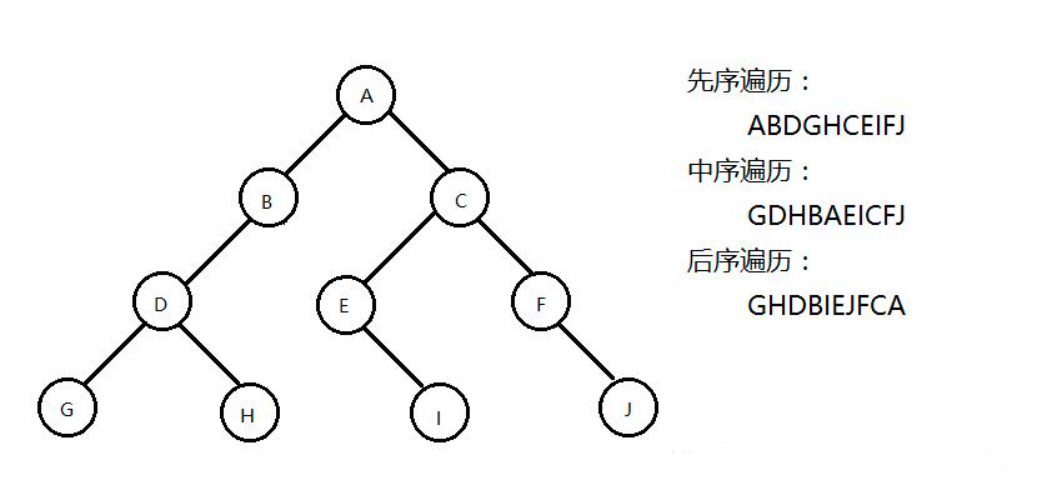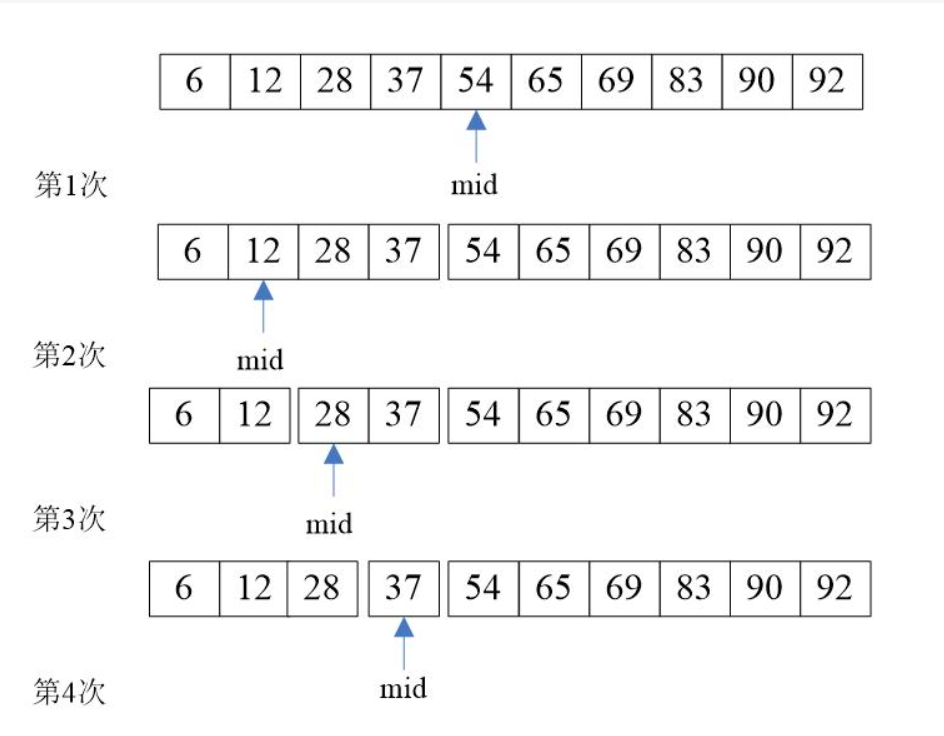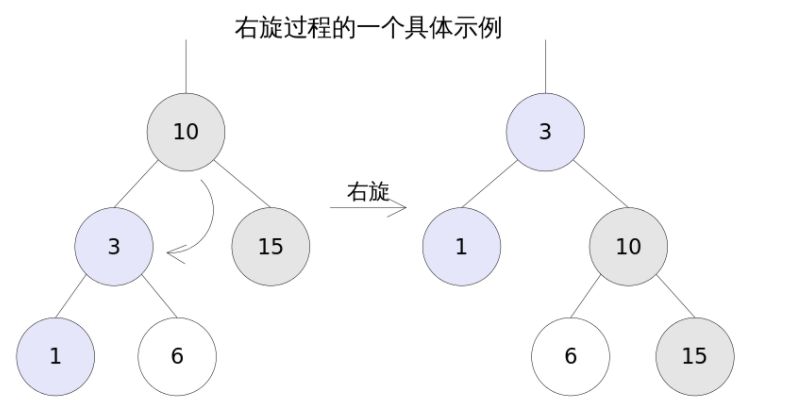[备份] 用Java手写红黑树
介绍
二叉搜索树
二叉树:树的每个节点最多只能有两个子节点
二叉搜索树:
- 左子树不为空,左子树上所有节点的值均小于它的根节点的值
- 右子树不为空,右子树上所有节点的值均大于它的根节点的值
参考图片

查找:搜索值小于当前节点搜左子树,大于当前节点搜右子树,等于表示搜到 插入:类似查找,直到左子树或右子树为空时认为找到了插入位置
遍历:
- 中序遍历:左-根-右(使用较多)
- 前序遍历:根-左-右
- 后序遍历:左-右-根
参考图片

最值:
- 最小值:最左边的节点
- 最大值:最右边的节点
删除:
- 叶节点:直接删(父节点指向空)
- 有一个子节点:由于二叉搜索树的特性,可以直接子承父位
- 有两个子节点:找到后继节点替换(大于该节点的最小节点)
二分查找
二分查找:数组有序情况下,对半查,参考下图

缺点:必须是有序的,而且是数组,不可以是链表
可以看出,二叉搜索树和二分查找有一定的相似度
AVL树
二叉搜索树存在一种极端情况,这种情况下会退化为一个有序链表

由于退化成链表后搜索效率过低,需要设计一种树,在插入元素的时候自动调整两边平衡,保持高查询性能。这里暂不分析AVL树,本节重点是红黑树
AVL树特点:
- 具有二叉树全部特性
- 左子树和右子树高度差最多是1
- 插入或删除时,会涉及到左旋和右旋操作

虽然AVL树解决了二叉搜索树的极端情况,但是由于高度差限制过于严格,导致效率过低
于是引出了红黑树的概念
基础
性质
红黑树具有以下的性质,如果满足那么这棵树就是趋于平衡状态的:
- 每个节点是黑色或红色
- 根节点是黑色
- 叶节点是黑色
- 每个红色节点的两个子节点是黑色,红色节点不能相连
- 任意节点到每个叶节点的路径都包含相同的黑节点,又称黑高
- 如果一个节点存在黑子节点,那么该节点一定有两个子节点

自平衡
- 变色:节点颜色红黑变化
- 左旋:某节点右子节点变成父节点,右子节点的左节点变为它的右节点,左子节点保持不变

- 右旋:某节点左子节点变成父节点,左子节点的右节点变为它的左节点,右子节点保持不变

实现
红黑树的插入等操作会涉及到多种情况,暂不分析,直接上代码,在代码中分析
树节点
xxxxxxxxxx// 树节点static class RBNode<K extends Comparable<K>, V> { private RBNode parent; private RBNode left; private RBNode right; private boolean color;
private K key; private V value;
// 构造 get set // ......}
左旋实现
xxxxxxxxxx/*** 左旋* p p* | |* x y* / \ ---> / \* lx y x ry* / \ / \* ly ry lx ly** (1) x.right=y.left* (2) y.left.parent=x* (3) y.parent=x.parent* (4) x.parent=y** @param x 左旋节点*/private void leftRotate(RBNode x) { RBNode y = x.right; // (1) x.right = y.left; // (2) if (y.left != null) { y.left.parent = x; } // (3) if (x.parent != null) { y.parent = x.parent; if (x == x.parent.left) { x.parent.left = y; } else { x.parent.right = y; } } else { // root this.root = y; } // (4) x.parent = y; y.left = x;}
右旋实现
xxxxxxxxxx/*** 右旋* p p* | |* y x* / \ ---> / \* x ry lx y* / \ / \* lx ly ly ry** (1) y.left=x.right* (2) x.right.parent=y* (3) x.parent=y.parent* (4) y.parent=x** @param y 右旋节点*/private void rightRotate(RBNode y) { RBNode x = y.left; // (1) y.left = x.right; // (2) if (x.right != null) { x.right.parent = y; } // (3) if (y.parent != null) { x.parent = y.parent; if (y == y.parent.left) { y.parent.left = x; } else { y.parent.right = x; } } else { // root this.root = x; this.root.parent = null; } // (4) y.parent = x; x.right = y;}
插入
xxxxxxxxxx/*** 对外的插入* @param key key* @param value value*/public void insert(K key, V value) { RBNode node = new RBNode(); node.setKey(key); node.setValue(value); // 新节点一定是红色 node.setColor(RED); insert(node);}
/*** 插入实现* @param node 插入节点*/private void insert(RBNode node) { RBNode parent = null; RBNode x = this.root;
while (x != null) { parent = x; // cmp>0:node.key>x.key->遍历右子树 // cmp=0:node.key=x.key->replace // cmp<0:node.key<x.key->遍历左子树 int cmp = node.key.compareTo(x.key); if (cmp > 0) { x = x.right; } else if (cmp == 0) { x.setValue(node.getValue()); return; } else { x = x.left; } } node.parent = parent; if (parent != null) { // cmp>0:node.key>parent.key->node在parent右子节点 // cmp<0:node.key<parent.key->node在parent左子节点 int cmp = node.key.compareTo(parent.key); if (cmp > 0) { parent.right = node; } else { parent.left = node; } } else { this.root = node; }
// 恢复平衡 insertFixup(node);}
恢复平衡
xxxxxxxxxxprivate void insertFixup(RBNode node) { this.root.setColor(BLACK); // 父节点 RBNode parent = parentOf(node); // 父节点的父节点 RBNode gparent = parentOf(parent); // 父节点为黑色直接平衡 // 父节点为红色应分多种情况 if (parent != null && isRed(parent)) { // 父节点的父节点的另一个子节点(叔叔) RBNode uncle = null; // 父节点是爷节点左节点 if (parent == gparent.left) { uncle = gparent.right; /** * | | * gp(B) gp(R) * / \ ---> / \ * p(R) u(R) p(B) u(B) * / / * n(R) n(R) */ if (uncle != null && isRed(uncle)) { // 重新染色后下一轮处理 setBlack(parent); setBlack(uncle); setRed(gparent); insertFixup(gparent); return; } if (uncle == null || isBlack(uncle)) { /** * | | * gp(B) p(B) * / \ ---> / \ * p(R) u(B) n(R) gp(R) * / \ * n(R) u(B) */ if (node == parent.left) { setBlack(parent); setRed(gparent); // 右旋 rightRotate(gparent); return; } /** * | | * gp(B) gp(B) * / \ ---> / \ ---> 上一步 * p(R) u(B) n(R) u(B) * \ / * n(R) p(R) */ if (node == parent.right) { leftRotate(parent); insertFixup(parent); // 右旋 return; } } } else { // 父节点是右节点 uncle = gparent.left; /** * | | * gp(B) gp(R) * / \ ---> / \ * u(R) p(R) u(B) p(B) * / / * n(R) n(R) */ if (uncle != null && isRed(uncle)) { // 重新染色后下一轮处理 setBlack(parent); setBlack(uncle); setRed(gparent); insertFixup(gparent); return; } // 不存在叔节点 if (uncle == null || isBlack(uncle)) { /** * | | * gp(B) p(B) * / \ ---> / \ * u(B) p(R) gp(R) n(R) * \ / * n(R) u(R) */ if (node == parent.right) { setBlack(parent); setRed(gparent); leftRotate(gparent); return; } /** * | | * gp(B) gp(B) * / \ ---> / \ ---> 上一步 * u(B) p(R) u(B) n(R) * / \ * n(R) p(R) */ if (node == parent.left) { rightRotate(parent); insertFixup(parent); return; } } } }}